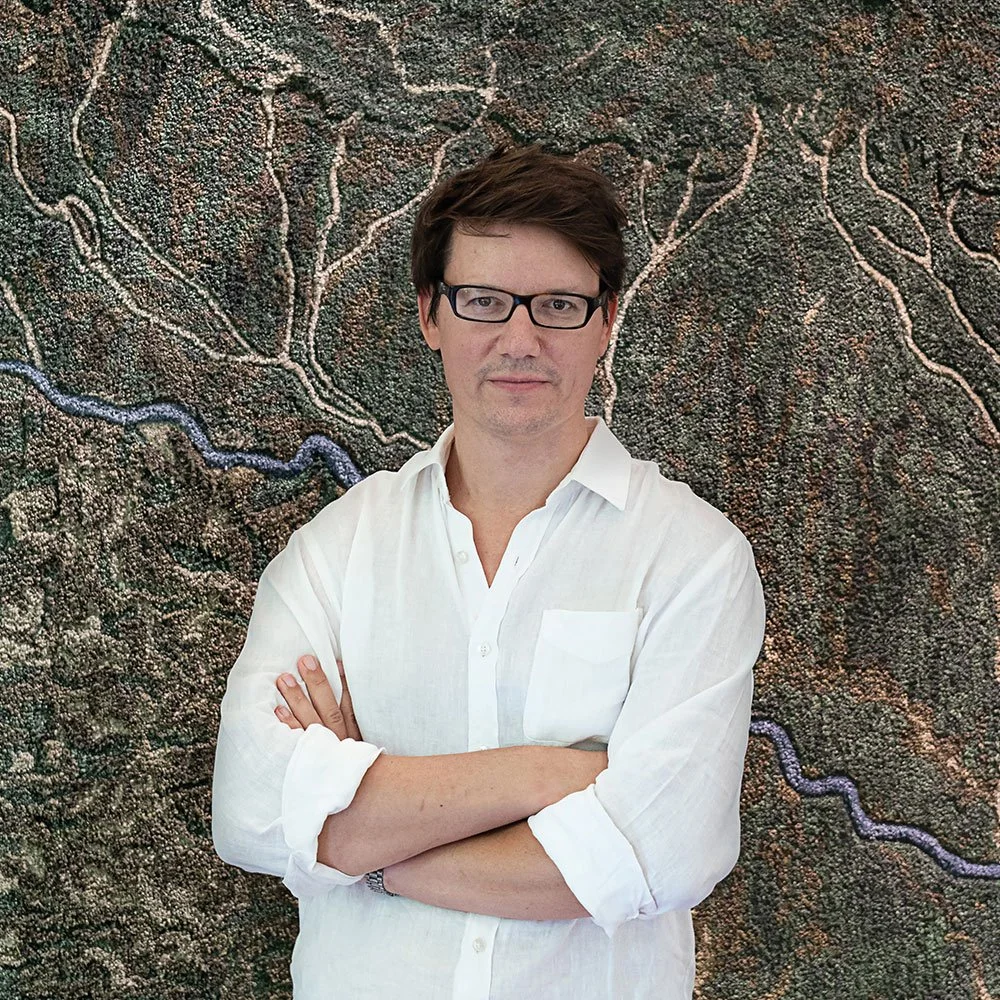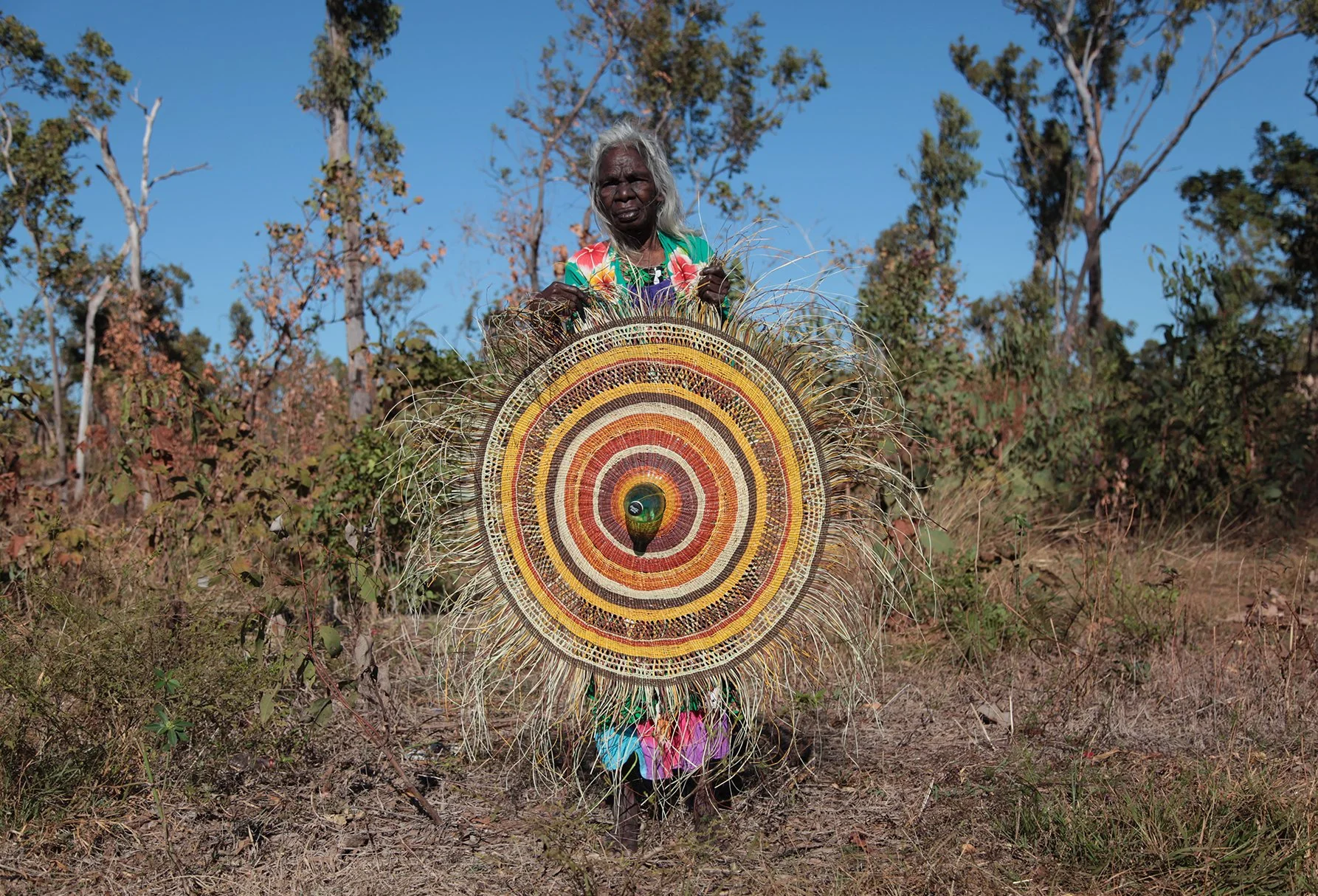Alvaro Catalan De Ocon and artisans
A collaboration between Madrid-based designer Álvaro Catalán de Ocón and a group of artisans in the Colombian Amazon and beyond, the PET Lamp collection is a vibrant, soulful project that transforms trash into treasure. Each PET Lamp is one of a kind. The shades are created by hand from discarded plastic bottles that are cut into strips and interwoven with dyed and undyed palm tree fibers by artisans in South America. Catalán de Ocón then assembles the electrical sockets and colorful fabric cords in his studio in Spain. This unique PET Lamp Chandelier brings together 21 individual pieces in a joyous celebration of craft and color—a true knockout. The look is fantastic, and the story behind it is even better.
Concerned about the accumulation of plastic waste choking the Colombian Amazon River, psychologist-activist Hélène Le Drogou invited a diverse group of specialists in 2011 to brainstorm solutions. As the representative designer, Catalán de Ocón was drawn to Colombia’s rich artisanal traditions and conceived a design that harnesses local weaving skills to give new life to discarded plastic bottles.
In 2012, Catalán de Ocón returned to Bogotá to create a workshop for weavers from Cauca who had been displaced by guerrilla warfare and went on to launch the PET Lamp collection in 2013 at the Salone del Mobile in Milan. Finding instant success, Catalán de Ocón received countless invitations to exhibit and sell in design venues around the globe, along with several prestigious awards, including a nomination for Product of the Year from the Design Museum in London. Now, Catalán de Ocón is expanding the project to work with artisans in Chile.
Álvaro Catalán de Ocón's approach to design is grounded in a highly sophisticated vision of what makes an object unique. His designs are clean and elemental, yet rich in experience and associations. The effortless and relaxed appearance of his creations is the result of an intensive process of study and reduction. After completing his business management studies, Álvaro began his training in product design at the Instituto Europeo di Design in Milan and later graduated with honors from Central Saint Martins in London. His thesis project, the GLOW BRICK, is still manufactured and distributed by Suck – UK. In 2004, he founded his own studio in Barcelona, where he designed the LA FLACA lamp, winner of the DESIGN PLUS AWARD. In 2009, he moved to Madrid, where he also taught at the Instituto Europeo di Design.
During 2011 and 2012, he conceived and developed the PET Lamp Project, which, since its presentation in 2013, has been a growing success. This success enabled him to establish the PET Lamp Studio Society to further expand the project. The project has received several awards and nominations: a nomination by the London Design Museum for Best Product of the Year, CODESPA for Best SME, the AD Prize for Best Emerging Design Studio, a nomination for the Delta Award 2014, and a nomination for the German Design Award 2015.
His work has been showcased in several galleries and events. He has also curated several exhibitions, including the Finnish Design Week exhibition "Helsinki – Madrid Findesign," held in 2010 at the cultural center El Matadero in Madrid, which he curated together with Pedro Feduchi and Kari Korkman.
Colombia
Colombia is a country defined by diversity: Drawing from European colonisation, African influences in the North, and a multitude of indigenous communities, the country’s multiracial population is spread over geography ranging from the lush rainforests of the Amazon up to the frozen heights of the Andes.
In 2012, the PET Lamp Team travelled to Colombia to embark on the very first PET Lamp Project. With the assistance of Artesanías de Colombia, we collaborated with two distinct indigenous communities; The Eperara-Siapidara, and Guambianos who despite hailing from the Cauca region, struggle with poverty in Bogota having been displaced by conflict.
Chile
In 2013, the PET Lamp Team set its sights on Chimbarongo. Located 150km South of Santiago, the rich soil and dry climate of the region has made it particularly well suited to the cultivation of wicker that was introduced to Chile by Spanish Colonists. Chimbarongo is now recognised as the wicker capital of the country, and our resulting collection reflects the austere beauty of this strong and simple material.
We returned to Chile in 2016, this time to collaborate with the Mapuche women of Huentelolen in the Araucania Region.
These women pass from one generation to the next a 500 year old weaving tradition that makes use of Ñocha, a plant that thrives in the well irrigated soil. The knowledge and skill they have built up over the centuries ensured a grand, striking collection that proved that the PET Lamp Project could succeed, even in a region notorious for conflict.
Ethiopia
Ethiopia possesses the most UNESCO World Heritage sites in Africa, and is a truly ancient land with many fascinating cultural, religious and architectural notes. The colourful baskets of Ethiopia are no exception and are regarded as functional, decorative and sacred elements throughout the country.
In Addis Abeba, Salem Kasshun has positioned her shop to specialise in basketwork. By gathering her own group of highly skilled weavers she has been able to achieve a greater flexibility and capacity for experimentation, making Salem’s Ethiopia the perfect collaborator for the PET Lamp Project.
Japan
Japan, in Asia’s far east, first encountered Buddhism in the late 6th century, which was introduced from China after spreading from India. Many Chinese and Korean craft techniques and inventions followed. Japan’s openness to other civilizations eventually came to an end, when, from the 17th to the mid-19th centuries, Japan cloistered itself from the outside world. This policy was so isolating that Japanese society developed in unique and often magnificent ways.
Eventually, bamboo became an essential material in tea ceremony culture as it developed during the 16th century, when every tool used in a ceremony, including the décor set around the room, was considered to convey important and holistic expressions of aesthetics, values and hospitality.
In the ancient capital of Kyoto, where many of Japan’s most elaborate fine crafts were established, highly delicate bamboo craftsmanship became one of the city’s signature industries, and master artisans passed their skills and titles—along with their pride—to successive generations.
Australia
For almost 65,000 years, the Aboriginal population of Australia lived in complete isolation and conserved a unique culture and ecosystem. Upon arrival of the Europeans at the end of the 18th century, the Aboriginal community was made up of a number of tribes that shared a worldview where the physical (the earth), the human and the sacred were totally integrated.
The Aboriginal vision was not taken into consideration by the colonists, where the European perspective predominated: exploitation of natural resources, accumulation by status, in which human superiority (European) overrode other considerations to create a society that was highly individualistic.
These fundamental differences led to a gap between Aboriginal and non- Aboriginal communities, leaving us with the task of discovering, accepting, transmitting and programming the knowledge of local peoples. In the search for this wealth, and to enable it to be valued by many more, we have sought communities where the traditions and worldview are conserved in their purest form. We had the opportunity to work together to take these paintings and give them back their living form as textiles.
Thailand
The character of Thai basketry tradition comes from the artisan’s calmness which is reflected through extremely precise and balanced pieces. Bamboo is the chosen material – typical of the Southeast Asia region– worked with precision and careful detail by the best craftsmen of the country.
As in previous occasions –through a methodology based on field research, prototyping and on-site workshops– PET Lamp has developed a collection of lampshades in collaboration with the Traditional Bamboo Handicraft Center, a foundation supported by her Majesty Queen Sirikit that enjoys a distinct reputation in the field of handicrafts in the country.
PET Lamp Pikul takes its name after the Mimusops Elengi’s flower. Also known as Spanish Cherry tree, it is a tropical tree found in the forests of this region of Asia. The flower grows in a geometric pattern inspiring the traditional Pikul pattern which can be found in many of the crafts around Thailand.
This material requires the skill and mastery of three craftsmen, each one specialized in one of the techniques of the manufacturing processes required to make each lamp.
Ghana
Bolgatanga, one of the most remote towns in Ghana, was the location chosen to develop the PET Lamp 2019, 2022 (PET Lamp Bolgatanga Large and Small) and 2023 (PET Lamp Gurunsi) projects.
In the heart of the Upper East Region and just a few kilometres from Burkina Faso, Bolgatanga is known as the “city of baskets” and is also the capital of the Gurunsi people. The importance given to basket weaving in this territory is one of the main reasons why we decided to go to this remote corner of Africa to develop three collections. Traditional basket weaving is regarded not only as a tool for day to day life and a livelihood for these people, it also helps to provide greater social cohesion and embodies the values expressed in their culture. All this makes basketry the biggest industry in this region.
During the workshops, we were able to discover a country full of surprises, a rich weaving culture, traditional buildings and enjoyed a close and easy-going relationship with the weavers, from whom we learnt the secrets of a technique full of riches. The experience also allowed us to open a window to enable them to update their traditional basketry by integrating PET bottles, which are a real and ongoing problem in this zone of Ghana.



















